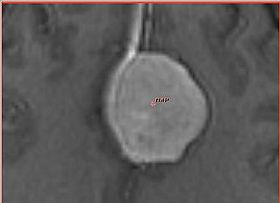Difference between revisions of "Modules:FastMarchingSegmentation-Documentation-3.5"
| Line 35: | Line 35: | ||
===Quick Tour of Features and Use=== | ===Quick Tour of Features and Use=== | ||
| − | |||
| − | |||
{| | {| | ||
| | | | ||
| + | Segmentation workflow of this module consists of the two steps: Initialization and adjustment of the segmentation result. | ||
* '''Initialization:''' The user is required to specify the following items to initialize the segmentation process: | * '''Initialization:''' The user is required to specify the following items to initialize the segmentation process: | ||
** ''Input volume'': image that contains the structure to be segmented | ** ''Input volume'': image that contains the structure to be segmented | ||
Revision as of 02:44, 13 December 2009
Home < Modules:FastMarchingSegmentation-Documentation-3.5Return to Slicer 3.5 Documentation
Fast Marching Segmentation
FastMarchingSegmentation
General Information
Module Type & Category
Type: Interactive
Category: Segmentation
Authors, Collaborators & Contact
- Andriy Fedorov, BWH
- Eric Pichon
- Contact: Andriy Fedorov, fedorov at bwh
Module Description
This module implements segmentation based on fast marching algorithm.
Usage
Examples, Use Cases & Tutorials
- This module is most useful to segment image regions that have similar intensity
- Initialization is very simple: points within the region to be segmented and expected volume of the segmented structure
- The segmentation is completed relatively quickly for typical images, facilitating experimentation with the selection of optimum parameters
- The resulting volume can be adjusted interactively by scrolling through the evolution of the label contour
Quick Tour of Features and Use
|
Segmentation workflow of this module consists of the two steps: Initialization and adjustment of the segmentation result.
Once these items have been specified, push Run Segmentation button to initiate the segmentation process.
Once the satisfactory result is achieved, Accept Segmentation Result button will finalize the segmentation. |
|
Development
Features under development:
- add volume rendering -- DONE
- add range control widget to simplify result adjustment -- DONE
- add progress reporting -- DONE
- add ability to initialize with label, not only with fiducials
- documentation
- simplify output label initialization process (selector widget) -- DONE
- integration with Editor
- switch active fiducial list when a new one is added -- DONE
- add parameter node
- Ron: specify the target segmented volume in either mm^3 or cm^3 or major dimensions (1x2x4cm)
- add volume rendering on/off capability -- DONE
Dependencies
Other modules or packages that are required for this module's use.
Known bugs
Follow this link to the Slicer3 bug tracker.
- Execution time of one of the algorithm components is O(max_image_intensity^2). A temporary workaround if the execution time is not acceptabe is to rescale the image to have intensity range of about 600 for reasonable performance. In the future, this step will be done automatically by the implementation.
Usability issues
Follow this link to the Slicer3 bug tracker. Please select the usability issue category when browsing or contributing.
Source code & documentation
Source code can accessed here
Links to documentation generated by doxygen.
More Information
Acknowledgment
Supported by Brain Science Foundation.
References
- Pichon E, Tannenbaum A, Kikinis R. A statistically based flow for image segmentation. Med Image Anal. 2004 Sep;8(3):267-74. PMID: 15450221. [1]




